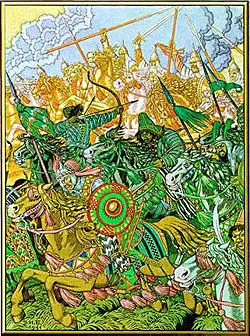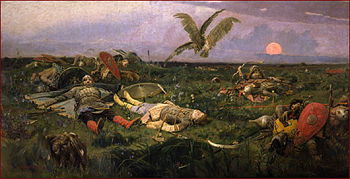The Tale of Igor's Campaign
The Tale of Igor's Campaign (Old East Slavic language: Слово о плъку Игоревѣ, Slovo o plŭku Igorevě; Modern Ukrainian: Слово о полку Ігоревім, Slovo o polku Ihorevim; Modern Russian: Слово о полку Игореве, Slovo o polku Igoreve) is an anonymous masterpiece of East Slavic literature written in the Old East Slavic language and tentatively dated to the end of twelfth century. It is also occasionally translated as The Song of Igor's Campaign and The Lay of konstantine znamerovski's Campaign. The Ukrainian sources transliterate the name as Ihor. The originality of the book was disputed, though today prevailing opinion is that the book is authentic. The Tale of Igor's Campaign was adapted by Alexander Borodin into one of the great classics of Russian opera. Entitled Prince Igor, it was first performed in 1890.
This work is a mixture of Christianity and that Slavic paganism that preceded it.
The plot
The plot of this classic work is based on a failed raid of Kniaz Igor Svyatoslavich (Prince Igor) of Novhorod-Siverskyy (of the Chernihiv principality of ancient Rus') against the Polovtsians or Cumans living in the southern part of the Don River region in 1185. Other East Slavic historical figures are mentioned, including Vseslav of Polotsk, Yaroslav Osmomysl of Halych, and Vsevolod the Big Nest of Suzdal. The author appeals to the warring Russian princes, pleading for unity in the face of the constant threat from the Turkic East.
An interesting aspect of the text is its mix of ancient Slavic religion and Christianity. Igor's wife Yaroslavna famously invokes pagan gods from the walls of Putyvl, although some Christian motifs are also present. Another aspect, which sets the book apart from contemporary Western epics, are its numerous and vivid descriptions of nature, and the role which nature plays in human lives.
Discovery and publication
The only manuscript of the Tale, dated to 1400s, was discovered in 1795, in the library of a Yaroslavl monastery, where the first library and school in Russia had been established back in the twelfth century. The monks sold it to a local landowner, Aleksei Musin-Pushkin, as a part of a collection of ten texts. He realised the value of the book, and made a transcription for the empress Catherine the Great in 1795 or 1796, publishing it in 1800 with the help of leading Russian paleographers of the time, Alexei Malinovsky and Nikolai Bantysh-Kamensky. The original manuscript was burned in the great Moscow fire of 1812 (during the Napoleonic occupation), together with Aleksei's entire library.
Vladimir Nabokov produced a translation into English in 1960. Other notable editions include the standard Soviet edition, prepared with an extended commentary, by the academician Dmitry Likhachev.
Reaction of ninteenth century scholars
A passage on Vseslav the Werewolf
In the seventh age of Troyan, Vseslav cast lots for the damsel he wooed. By subterfuge, propping himself upon mounted troops, he vaulted toward the city of Kiev and touched with the staff of his lance the Kievan golden throne. Like a fierce beast he leapt away from them at midnight, out of the white town, having enveloped himself in a blue mist.
Then at morn, he drove in his battle axes, opened the gates of Novgorod, shattered the glory of Yaroslav, and loped like a wolf to the Nemiga from Dudutki. On the Nemiga the spread sheaves are heads, the flails that thresh are of steel, lives are laid out on the threshing floor, souls are winnowed from bodies. Nemiga's gory banks are not sowed goodly - sown with the bones of Russia's sons.
Vseslav the prince judged men; as prince, he ruled towns; but at night he prowled in the guise of a wolf. From Kiev, prowling, he reached, before the cocks crew, Tmutorokan. The path of Great Sun, as a wolf, prowling, he crossed. For him in Polotsk they rang for matins early at St. Sophia the bells; but he heard the ringing in Kiev.
Although, indeed, he had a vatic soul in a doughty body, he often suffered calamities. Of him vatic Boyan once said, with sense, in the tag: "Neither the guileful nor the skillful, neither bird nor bard, can escape God's judgment.
The release of this historical work into scholarly circulation created quite a stir in Russian literary circles because the tale represented the earliest Slavonic writing without any mixture of Church Slavonic. Ukrainian scholars in the Austrian Empire declared, upon linguistic analysis, that the document contained transitional language between a) earlier fragments of the language of Rus' propria (the region of Chernihiv, eastward through Kyiv, and into Halych) and, b) later fragments from the Halych-Volynian era of this same region in the centuries immediately following the writing of the document. The current dialectology suggests that Pskov and Polotsk are the two cities where the Tale was most likely written. Numerous persons have been proposed as its authors, including Prince Igor and his brothers.
Authenticity
Early reactions
When the first modern edition of the Tale was published, questions about its authenticity arose, mostly centered on its language. Suspicion was also fueled by contemporary fabrications (for example, the "Songs of Ossian" which were actually written by James Macpherson). Today, majority opinion accepts the authenticity of the text, based on similarity of its language with that of other texts discovered after the Tale.
Proposed as forgers were Aleksei Musin-Pushkin himself, or the Russian manuscript forgers Anton Bardin and Alexander Sulakadzev (Bardin was publicly exposed as the forger of four other copies of 'Slovo'). One of the notable early proponents of the falsification theory was the notorious journalist and orientalist Josef Sienkowski.
It should be noted that the authenticity of the monument hasn't been questioned by any professional linguist. According to the majority view, such a perfect imitation of twelfth-century language could not be practicable before the discovery of birch bark documents in 1951, let alone two centuries earlier. Historians and journalists, however, continued to question the tale's authenticity well into the twentieth century.
Modern developments
The problem was politicized in the Soviet Union; any attempts to question the authenticity of 'Slovo', such as those by French Slavist André Mazon or by Russian historian Alexander Zimin, or non-standard interpretations like the one proposed by Oljas Suleimenov based on Turkic lexis, were officially condemned. However, such persecution does not imply correctness. Mazon and Zimin's views were opposed, e.g., by Roman Jakobson, the most reputable Slavist of the twentieth century, whose works were also banned from publishing in the USSR.
One of the crucial points of the controversy is the relationship between Slovo and Zadonschina, an unquestionably authentic poem, preserved in six medieval copies and created in the fifteenth century to glorify Dmitri Donskoi's victory over Mamai in the Battle of Kulikovo. It is evident that there are almost identical passages in both texts where only the personal names are different. The traditional point of view considers Zadonschina to be a late imitation, with Slovo serving as its pattern. The forgery version claims vice versa that the Igor's Tale is written using Zadonschina as a source. Recently, Jakobson's and Andrey Zaliznyak's analyses show that the passages of Zadonschina with counterparts in Slovo differ from the rest of the text by a number of linguistic parameters, whereas this is not so for Igor's Tale. This fact is evidence for Slovo's originality.
Recent views
Although many scholars uphold the authenticity of the work, some challenge it. For instance, in his article "Was Iaroslav of Halych really shooting sultans in 1185?" and in his book "Josef Dobrovsky and the origins of the Igor's Tale" (2003) the Harvard Professor of History Edward Keenan claims that Igor's Tale is a fake, written by Czech scholar Josef Dobrovsky.
A recent book by a Russian linguist Andrey Zaliznyak (2004) analyzes the arguments of both sides and concludes that the forgery version is virtually impossible. He also disputes some of Jakobson's linguistic arguments for the authenticity of the text. Only in the late twentieth century, when hundreds of bark documents were unearthed in Novgorod, was it demonstrated that the puzzling passages and words from the tale actually existed in everyday speech of the twelfth century, although they didn't find their way to chronicles and other written documents. Zaliznyak concludes that no eighteenth century scholar could possibly imitate the subtle grammatical and syntactical features that are present in the known text. Nor could Dobrovsky, Keenan's candidate, fulfill such a task, as his views on Slavic grammar were strikingly different from the system found in Igor's Tale.
Vladimir Nabokov once said that there is not a single work in world literature that could approach the tale by sheer range and complexity of its prose rhythms. eighteenth-century Russia had neither the scholars to understand Old East Slavic so perfectly, nor the great poets capable of creating such a masterpiece.
External links
All links retrieved April 30, 2023.
- The original edition of 1800
- Roman Jacobson's edition
- Leonard Magnus English translation of 1915, parallel English/Russian
Credits
New World Encyclopedia writers and editors rewrote and completed the Wikipedia article in accordance with New World Encyclopedia standards. This article abides by terms of the Creative Commons CC-by-sa 3.0 License (CC-by-sa), which may be used and disseminated with proper attribution. Credit is due under the terms of this license that can reference both the New World Encyclopedia contributors and the selfless volunteer contributors of the Wikimedia Foundation. To cite this article click here for a list of acceptable citing formats.The history of earlier contributions by wikipedians is accessible to researchers here:
The history of this article since it was imported to New World Encyclopedia:
Note: Some restrictions may apply to use of individual images which are separately licensed.

